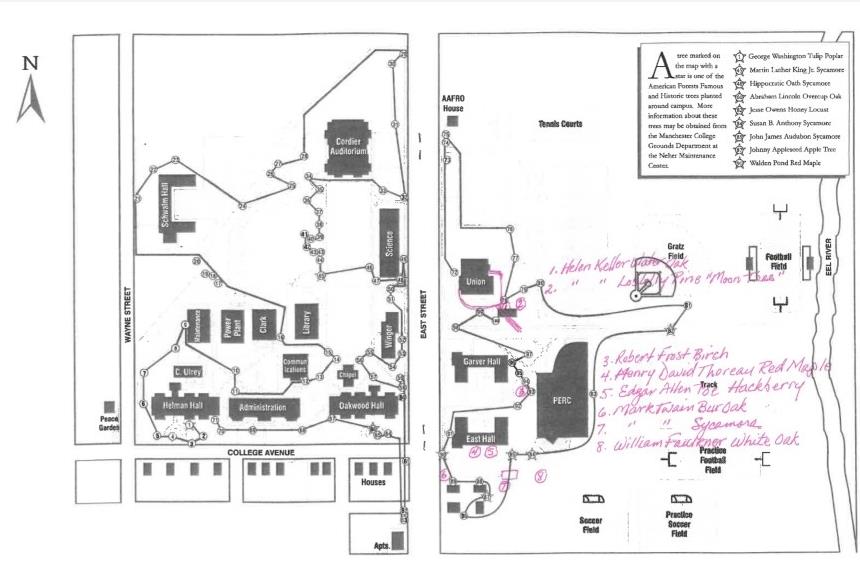
A map of the North Manchester campus shows the locations of all the famous authors’ trees that have been planted across campus.
Map markup courtesy of David Good
Manchester Plants Literary Trees across Campus
James Walsh
In years past, famous authors from across the country have sat on their estates writing tales of adventure and glory while gazing across a serene landscape. Today the authors themselves have passed on, but the scenery that they revered while writing remains, even here at Manchester University. Across this campus, varieties of trees sprouted from the clippings of these great American authors’ estates flourish.
The trees’ healthy condition was made possible by now-retired Manchester University groundskeeper, David Good, who bears a special connection and reverence for the literary trees. “Brady Forman, my successor as grounds coordinator, agreed to let me plant 40 different kinds of trees on campus this past spring,” Good said, “one for each of the years I have worked at MU.”
The trees themselves come from a variety of well-established and famous authors’ estates. These include the Helen Keller Water Oak, the Robert Frost Birch Tree, the Helen Keller Loblolly Pine “Moon Tree”, the Mark Twain Sycamore, the Edgar Allan Poe Hackberry, the Mark Twain Bur Oak and the Henry David Thoreau Walden Woods Red Maple. Other trees of interest on campus include several saplings from George Washington’s estate, two Franklin D. Roosevelt Trees, and a tree born of a parent tree that sent its seed to the moon.
Where were they planted and why that location? “They were planted in areas where there was enough room for the particular varieties to grow,” Good said. “I was interested in having them somewhat in the same area--the area south of East Hall and south of the PERC, plus the two Helen Keller trees by the southeast corner of the Switzer Center.
“I planted the trees in April and watered them until I retired on July 1,” Good continued. “The grounds crew has continued that task. They all seem to have established themselves fairly well going into their first winter. Usually, if saplings like this can get established in their first growing season in the ground, they stand a pretty good chance of growing into big guys.”
The trees from this spring were obtained from a company called American Heritage Trees. Accompanying each tree were certificates signed by the president of the company that offers background information on the author and the legacy they leave in the tree itself. Of the trees Good planted this spring, 15 were from the American Heritage Nursery.
These trees turn a simple daily walk across campus into an adventure peppered with bits and pieces of America’s literary and cultural history. Good wanted something like that to happen. “The trees offer a living, breathing connection to these historical characters, many of whom drew some of their own inspirations from nature,” he said. “I think it's an interesting opportunity for any of us to think about the connections over time and space to these historical literary figures. Maybe students can draw some of their own inspirations in the presence of these special trees.”